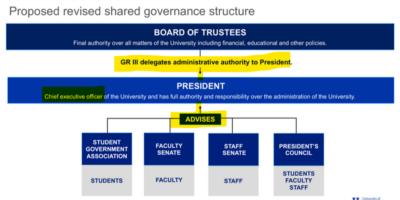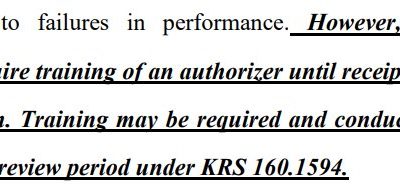Yesterday morning, Senator Rand Paul announced the introduction of his new bill, the Higher Education Loan Repayment and Enhanced Retirement (HELPER) Act. Briefly, the bill allows individuals to withdraw as much as $5250 each year, from either an 401(k) or Individual Retirement Account (IRA), to pay for either college tuition or student loans, with no income taxes assessed on the withdrawal.
Senator Paul announced his plan, here in Lexington, in an editorial published in the Herald Leader. Let’s take a look at it.
While you often hear me sounding the alarm over our country’s national deficit, that’s not the only debt in need of serious attention. In the last decade, U.S. student loan debt has skyrocketed to its highest ever at $1.6 trillion, with the average 2018 college graduate owing approximately $29,200 in student loans.
This is largely true. Paul does sound the national deficit alarm rather frequently. Of course, he happily voted for the 2017 corporate tax-cut bill that has already sent the deficit zooming upward, thus leaving today’s college students, and their children, and their children’s children, on the hook for at least a trillion dollars of additional debt over the next decade. But fair enough: he’s right that student loan debt is a problem.
Paul doesn’t state where he found that $29,200 figure, but let’s assume, for argument’s sake, that it’s reliable. Divided by four years, that’s $7300 of loan debt annually. And herein lies the first problem with Rand’s plan: given that the average annual tuition for even an in-state student attending a state school is now more than $10,000, while private-school tuition is more than $36,000, one must assume that the $29,200 in average student loan debt is what’s left after students have already paid at least part of their tuition up front. To be sure, some students may pay all of their tuition with loans, and some don’t use loans at all, but for many students, that $7300 in annual debt accumulation is on top of whatever they’ve already paid.
Currently, everyone has to pay student loans with money out of their pockets that has already been taxed. My bill would instead allow individuals to take, tax and penalty free, up to $5,250 from their 401(k) or IRA annually to pay for college or to pay back student loan debt, and it can be used to pay tuition and expenses for a spouse or dependent.
There’s nothing wrong with this idea. It’s fundamentally an income-tax break for any money used to pay college tuition—except that the money must first be funneled through a retirement plan. Let’s examine the 401(k) route first: contributions to those plans are pre-income tax (though not free of FICA taxes), and thus any money you use to pay tuition and loans from a 401(k) won’t have been touched by income taxes at all. But how many Americans have access to an employer-sponsored 401(k) in the first place? About half, it turns out. Nor are all employees able to contribute much to their 401(k) plans in the first place; very few Americans contribute the recommended 10%-15% of their incomes each year, presumably because they have day-to-day living expenses to cope with.
Then there are IRAs: contributions to traditional IRAs are tax-deferred, meaning that you don’t pay until you withdraw, while contributions to Roth IRAs are made after taxes are assessed—but you pay nothing when you withdraw (after age 59 1/2 for both traditional and Roth IRAs). Paul’s plan would thus benefit holders of traditional IRA plans much more than those of Roth IRAs. While in either case the holder would dodge early-withdrawal penalties, Roth IRA investors would have already paid taxes on their contributions. Paul doesn’t address this disparity in his editorial.
But how many Americans invest in either form of IRA? About 41%. And of that number, an increasing majority are of sufficient wealth that student loans are not the financially crippling propositions that they are for working class and poor families. As Berkeley professor Martin Lettau and others have documented, despite the spread of 401(k) plans and similar investment vehicles, “stock ownership is still highly concentrated” among wealthier Americans. Put simply, the wealthier you are, and thus the less likely you are to worry about big expenses like college tuition, the more likely you are to have significant investments in retirement accounts; conversely, if you’re relatively poor, you probably aren’t saving much for retirement in the first place.
The primary problem with the senator’s plan, of course, is that it’s a case of robbing Peter to pay Paul. Money that you take from your retirement account to pay for college tuition or student loans is money that you no longer possess for your retirement. Senator Paul makes the argument, fairly, that the interest a student and his or her family pays on student loans is likely to be higher than whatever return they might receive from their investment accounts, although citing only 2%-yield U.S. bonds is lowballing the potential return. It isn’t quite a zero sum game, but the fact remains, $5250 paid to college loans today is $5250 less at retirement age.
Hence Senator Paul’s HELPER Act, while surely beneficial to many Americans, seems designed to benefit the middle and upper economic classes rather more than the lower. He offers this plan as a small-government counterargument to the “socialist” alternatives currently proffered by certain prominent left-leaning politicians, but as usual, it isn’t designed to help all Kentuckians, and certainly not those who need help the most.





Michael Benton
How about we adopt The Nordic Model and make education free for all as an investment in our collective future and a way of allowing young people to be more autonomous (not dependent on parents, not dependent on the state, not burdened by debt for decades afterward).
Now I know this is going to be a hard proposition for the typical American propagandized to believe that this would be socialism. I hope to tackle irrational fear soon!
What Paul fails to make clear is “Student loan debt in the U.S. reached another all-time high of $1.4 trillion in the first quarter (Q1) of 2019, according to Experian data. That’s an increase of 116% in 10 years and represents one of the country’s most significant and widespread financial burdens to date.” (Experian is credit reporting agency and as a result has a good grasp of this problem – https://www.experian.com/blogs/ask-experian/state-of-student-loan-debt/ )
Paul’s detachment from the realities of most of the people in his state is clear in his proposal and your analysis.
Thanks Keith